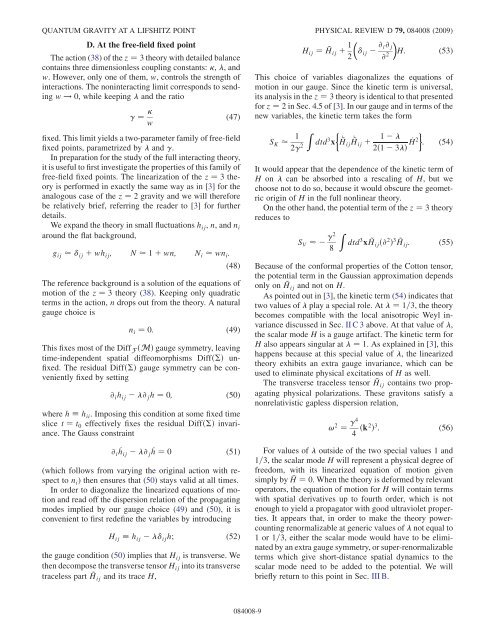Quantum gravity at a Lifshitz point
Quantum gravity at a Lifshitz point
Quantum gravity at a Lifshitz point
Create successful ePaper yourself
Turn your PDF publications into a flip-book with our unique Google optimized e-Paper software.
QUANTUM GRAVITY AT A LIFSHITZ POINT PHYSICAL REVIEW D 79, 084008 (2009)H ij ¼ ~H ij þ 1 @ i @ j2 ij@ 2 H: (53)D. At the free-field fixed <strong>point</strong>The action (38) of the z ¼ 3 theory with detailed balancecontains three dimensionless coupling constants: , , andw. However, only one of them, w, controls the strength ofinteractions. The noninteracting limit corresponds to sendingw ! 0, while keeping and the r<strong>at</strong>io ¼ w(47)This choice of variables diagonalizes the equ<strong>at</strong>ions ofmotion in our gauge. Since the kinetic term is universal,its analysis in the z ¼ 3 theory is identical to th<strong>at</strong> presentedfor z ¼ 2 in Sec. 4.5 of [3]. In our gauge and in terms of thenew variables, the kinetic term takes the formfixed. This limit yields a two-parameter family of free-fieldfixed <strong>point</strong>s, parametrized by and .In prepar<strong>at</strong>ion for the study of the full interacting theory,it is useful to first investig<strong>at</strong>e the properties of this family offree-field fixed <strong>point</strong>s. The lineariz<strong>at</strong>ion of the z ¼ 3 theoryis performed in exactly the same way as in [3] for theanalogous case of the z ¼ 2 <strong>gravity</strong> and we will thereforebe rel<strong>at</strong>ively brief, referring the reader to [3] for furtherdetails.We expand the theory in small fluctu<strong>at</strong>ions h ij , n, and n iaround the fl<strong>at</strong> background,g ij ij þ wh ij ; N 1 þ wn; N i wn i :(48)The reference background is a solution of the equ<strong>at</strong>ions ofmotion of the z ¼ 3 theory (38). Keeping only quadr<strong>at</strong>icterms in the action, n drops out from the theory. A n<strong>at</strong>uralgauge choice isn i ¼ 0: (49)This fixes most of the Diff F ðMÞ gauge symmetry, leavingtime-independent sp<strong>at</strong>ial diffeomorphisms DiffðÞ unfixed.The residual DiffðÞ gauge symmetry can be convenientlyfixed by setting@ i h ij @ j h ¼ 0; (50)where h h ii . Imposing this condition <strong>at</strong> some fixed timeslice t ¼ t 0 effectively fixes the residual DiffðÞ invariance.The Gauss constraint@ i_ h ij@ j_ h ¼ 0 (51)(which follows from varying the original action with respectto n i ) then ensures th<strong>at</strong> (50) stays valid <strong>at</strong> all times.In order to diagonalize the linearized equ<strong>at</strong>ions of motionand read off the dispersion rel<strong>at</strong>ion of the propag<strong>at</strong>ingmodes implied by our gauge choice (49) and (50), it isconvenient to first redefine the variables by introducingH ij h ij ij h; (52)the gauge condition (50) implies th<strong>at</strong> H ij is transverse. Wethen decompose the transverse tensor H ij into its transversetraceless part ~H ij and its trace H,S K 1 Z dtd 32 2 x ~H _ij_~H ij þ 1 H:2ð1 3Þ _ 2 (54)It would appear th<strong>at</strong> the dependence of the kinetic term ofH on can be absorbed into a rescaling of H, but wechoose not to do so, because it would obscure the geometricorigin of H in the full nonlinear theory.On the other hand, the potential term of the z ¼ 3 theoryreduces toS V 28Zdtd 3 x ~H ij ð@ 2 Þ 3 ~H ij : (55)Because of the conformal properties of the Cotton tensor,the potential term in the Gaussian approxim<strong>at</strong>ion dependsonly on ~H ij and not on H.As <strong>point</strong>ed out in [3], the kinetic term (54) indic<strong>at</strong>es th<strong>at</strong>two values of play a special role. At ¼ 1=3, the theorybecomes comp<strong>at</strong>ible with the local anisotropic Weyl invariancediscussed in Sec. II C 3 above. At th<strong>at</strong> value of ,the scalar mode H is a gauge artifact. The kinetic term forH also appears singular <strong>at</strong> ¼ 1. As explained in [3], thishappens because <strong>at</strong> this special value of , the linearizedtheory exhibits an extra gauge invariance, which can beused to elimin<strong>at</strong>e physical excit<strong>at</strong>ions of H as well.The transverse traceless tensor ~H ij contains two propag<strong>at</strong>ingphysical polariz<strong>at</strong>ions. These gravitons s<strong>at</strong>isfy anonrel<strong>at</strong>ivistic gapless dispersion rel<strong>at</strong>ion,! 2 ¼ 44 ðk2 Þ 3 : (56)For values of outside of the two special values 1 and1=3, the scalar mode H will represent a physical degree offreedom, with its linearized equ<strong>at</strong>ion of motion givensimply by €H ¼ 0. When the theory is deformed by relevantoper<strong>at</strong>ors, the equ<strong>at</strong>ion of motion for H will contain termswith sp<strong>at</strong>ial deriv<strong>at</strong>ives up to fourth order, which is notenough to yield a propag<strong>at</strong>or with good ultraviolet properties.It appears th<strong>at</strong>, in order to make the theory powercountingrenormalizable <strong>at</strong> generic values of not equal to1or1=3, either the scalar mode would have to be elimin<strong>at</strong>edby an extra gauge symmetry, or super-renormalizableterms which give short-distance sp<strong>at</strong>ial dynamics to thescalar mode need to be added to the potential. We willbriefly return to this <strong>point</strong> in Sec. III B.084008-9



![arXiv:1001.0993v1 [hep-ph] 6 Jan 2010](https://img.yumpu.com/51282177/1/190x245/arxiv10010993v1-hep-ph-6-jan-2010.jpg?quality=85)


![arXiv:1008.3907v2 [astro-ph.CO] 1 Nov 2011](https://img.yumpu.com/48909562/1/190x245/arxiv10083907v2-astro-phco-1-nov-2011.jpg?quality=85)







![arXiv:1002.4928v1 [gr-qc] 26 Feb 2010](https://img.yumpu.com/41209516/1/190x245/arxiv10024928v1-gr-qc-26-feb-2010.jpg?quality=85)
![arXiv:1206.2653v1 [astro-ph.CO] 12 Jun 2012](https://img.yumpu.com/39510078/1/190x245/arxiv12062653v1-astro-phco-12-jun-2012.jpg?quality=85)
